How to make your own Sourdough Starter, using simple ingredients with no special equipment, in just six days, that can be used in our sourdough bread. Video.
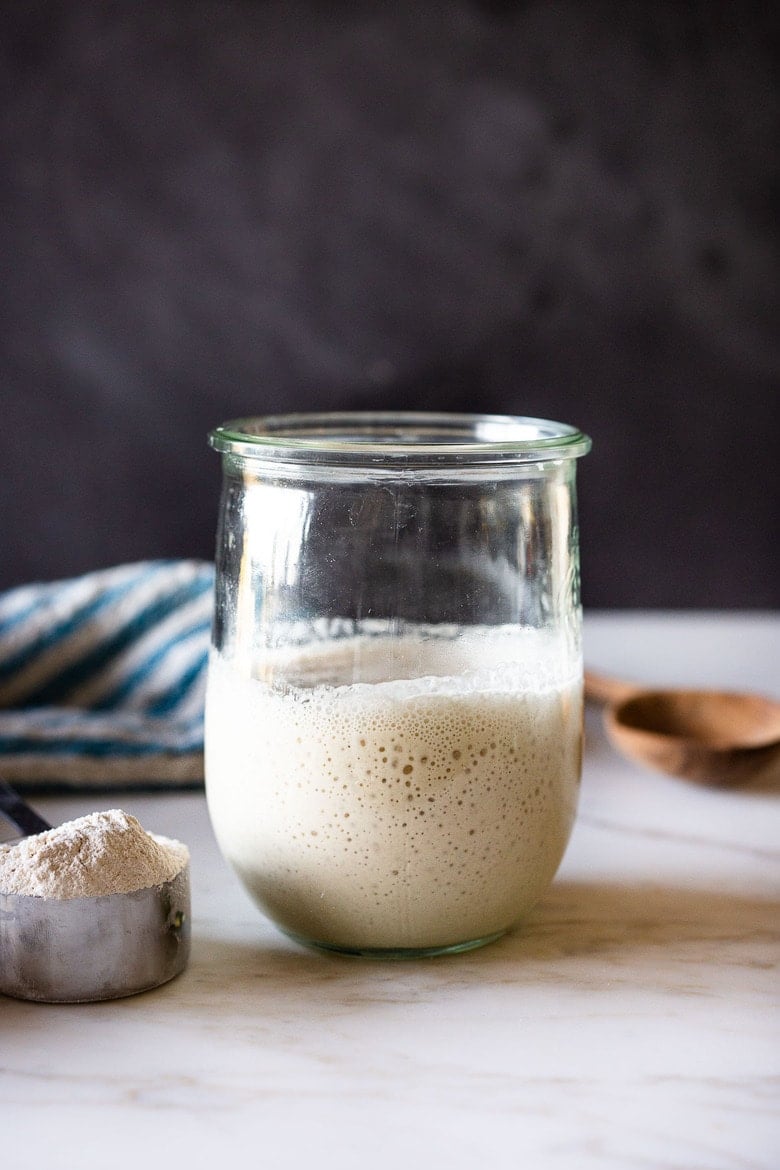
When you understand one thing through and through, you understand everything.~ Shunryu Suzuki
With over 500 five-star reviews and hundreds of success stories, my chef’s perfected sourdough starter guide has everything you need to make your own homemade starter. In just six days, you’ll be baking the most beautiful sourdough loaves!
But first, What is a starter?
Sourdough starter is a “wild yeast” made from flour, water, and the natural wild yeast in the air. With a little care and patience, it ferments, and when strong and active, just a little bit of starter replaces commercial yeast and makes your bread rise, while transforming the gluten in the bread into something more easily digestible. Store-bought yeast is not needed!
How to Make Sourdough Starter | 20-Min Video
***Don’t see the video? Allow 15-20 seconds to load it right here!*** (Still don’t see it? Check that your ad blocker is turned off; use Chrome for the best experience.)
Fast forward to Specific Day by video time (using scroll bar underneath video)
- Day 1 Morning: :23
- Day 2 Morning: 4:10
- Day 3 Morning: 7:00
- Day 3 Evening: 9:12
- Day 4 Morning: 11:50
- Day 4 Evening: 13:37
- Day 5 Morning: 14:45
- Day 6 Evening: 16:50
- Day 6 Morning: 18:12
- Day 6 Evening: 20:10
Sourdough Starter Recipe Ingredients
- Jar – A wide-mouth quart jar or a Weck’s 1-liter tulip jar.
- Flour – 5 lb bag of organic bread flour (plus 1 cup organic whole grain flour )
- Water – filtered water, tap water, or mineral water (specifically, San Pellegrino, for the correct mineral ratio). Distilled water does not have enough minerals.
- Scale – using a kitchen scale is optional but handy.
- Thermometer – Knowing the temp of the starter using a thermometer is optional but handy!
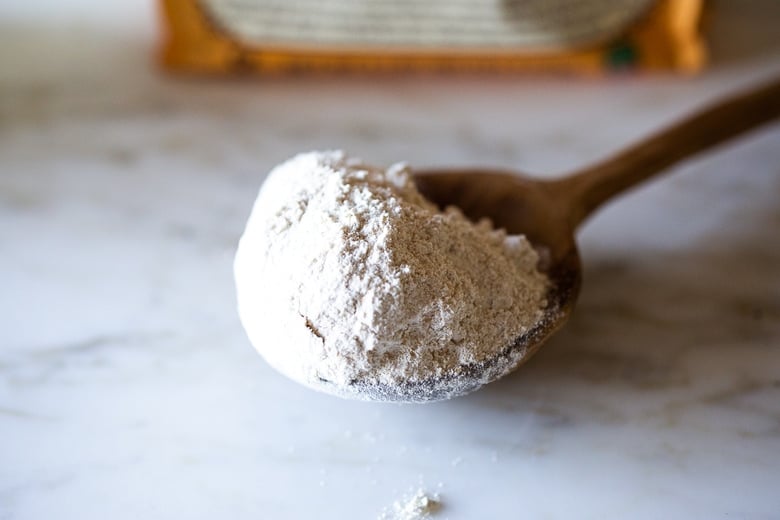
Understanding starter
- Think of sourdough starter as yeast. Only in this case, instead of buying a packet of yeast from the store, you are making your own living “wild yeast” by fermenting flour and water. Once it’s bubbly and happy, it is very much ike a very low-maintenance pet.
- You must feed it (stir in a mixture of flour and water) once a week to keep it active and strong. You know it’s happy when it bubbles. 😉 And YES, you can even name it.
- Some people believe that bread made with sourdough starter is actually better for you than bread made with yeast. Here and Here are a few articles to get you started on your own research. While I’m not sure if this is scientifically proven, I do know that bread made with sourdough starter, tastes infinitely better, feels easier to digest, and has more complexity and better texture, than bread made with commercial yeast. So if you are a bread lover- this is absolutely the way to go, as far as the quality of your finished bread.
How to Make Sourdough Starter
*See the recipe card for detailed instructions.
This recipe for Sourdough Starter takes 6 days (or up to 12 days if it is very cold where you live). For a primer, watch the 20-minute Sourdough Video above!
Day 1: Staring in the morning or at night, using a wide-mouth quart jar, tulip jar, or Crock or Glass Measuring Cup , mix 1 cup whole grain flour (120 grams) with 1/2 cup filtered water (120 grams) using a fork (or chopstick) making sure you’ve incorporated all the dry flour.
Place the lid lightly on top (using the Weck jar lid is really handy here) or a wet towel to keep moisture in, or plastic wrap- and let sit at room temperature (70-ish degrees) on the kitchen counter for 24-48 hours. If you are unsure how warm it is, use a kitchen thermometer and check it a few hours later. See notes for TEMPERATURE.
TIP #1: For your first measurement, weigh the flour using a kitchen scale so you can get an idea of how the mixture should feel. Do not weigh the measuring cup! It should be like a thick paste, like peanut butter. If you need to add a little more water to incorporate the flour, that is OK too!
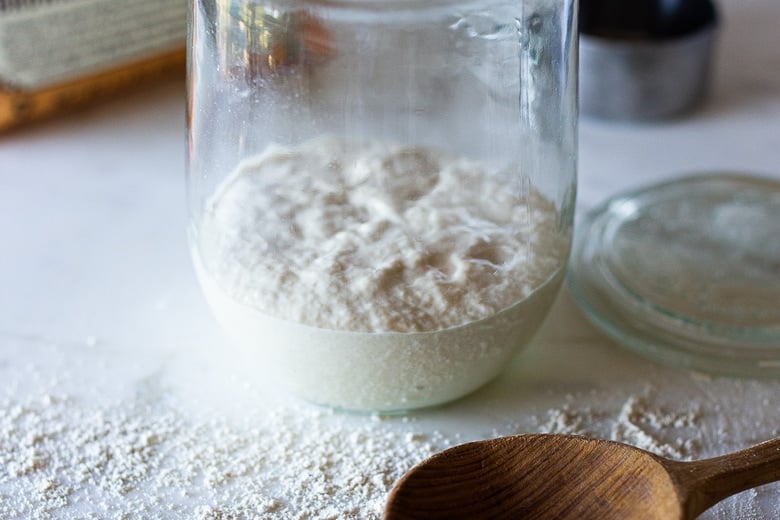
Day 2: After the first 24 hours, there may or may not be a bit of bubbling. Let the mixture rest until you see activity (bubbles or rising) sometimes this takes 36 hours or even 48 hours if very cold. When you see active bubbling, discard all but 1/2 cup of the starter (4 ounces).
To the remaining ½ cup of starter, stir in 1/2 cup water (120 grams), and mix well with a fork. Add 1 cup of organic bread flour (120 grams)spooned and leveled. Stir until combined. Again, it should feel like a thick paste. If overly dry, feel free to add a bit more water. Cover again and allow the mixture to sit at room temperature for another 24 hours.
Day 3: After 24 hours, hopefully, you will see some bubbling or rising and if not, let it go a bit longer until you see activity. Be patient.
Depending on how warm your house is and how active your starter, you may need to begin feeding more often or move to two feedings a day, in the morning and at night. If it is cold, one feeding a day may be enough.
TIP #2: Only feed the starter after it has peaked or looks hungry. See the “3 Signs of Hunger” below. Feeding it when it is “not hungry” will basically dilute all the growing yeast and make it lethargic. Better to underfeed than overfeed.
The 3 Signs of hunger
The photo below was taken after the starter was fed, and after it peaked (reached its highest), and now is sliding down. It is now “hungry” again. See the downward slide marks on the jar? Pay attention – your starter is telling you it is hungry.
- Look for “slide marks” (be sure to use a clean jar so you can see these clearly).
- Liquid at the top of the starter.
- Thin and runny. The starter is liquidy enough to pour out of the jar (when at room temp).

This might be 12 hours, it might be 14, it might be 18, or 24, depending on the temp in your house. In very warm climates, it may only be 6-8 hours. In winter, this may take 36 hours. It is better to underfeed rather than overfeed here.
For each feeding, discard all but 1/2 cup of the starter (keeping roughly ½-cup of starter in the jar). Add 1/2 cup water and 1 cup Bread Flour (spooned and leveled). Mix well, cover, and let this rest at room temperature for 12-24 hours or until the starter looks “hungry” again before repeating.
Day 4: Feed 1-2 times, discarding all but 1/2 cup of starter each time. Feed 1 cup bread flour, 1/2 cup water.
TIP #3: It is typical on day 4 for the starter to slow down and stall a bit. This is OK. Just keep going, be patient and look for the hunger signs, and only feed when clearly hungry. Hopefully, you’ll begin to see some rising and falling. It’s helpful to put the starter in a clean jar each day and mark the beginning level (with a sharpie, string or rubber band) so you can easily see this.
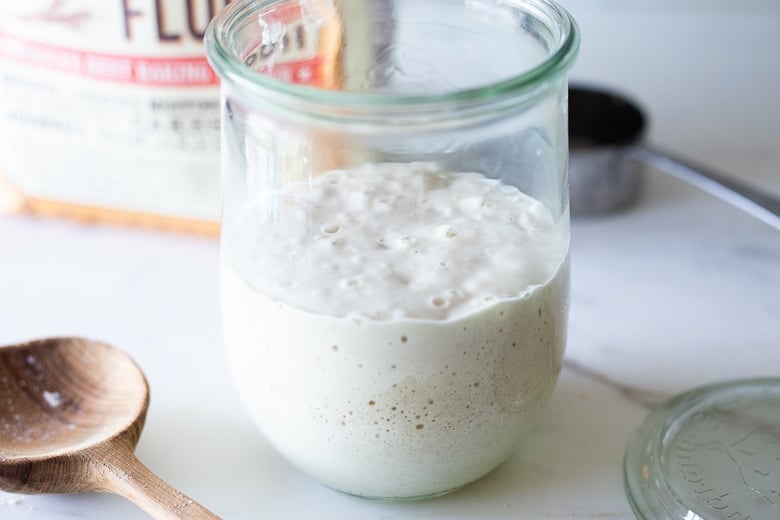
Above, you’ll see it peaking, and below, you’ll see it deflating and getting “hungry.” There may not be too much difference in the beginning, so look closely.
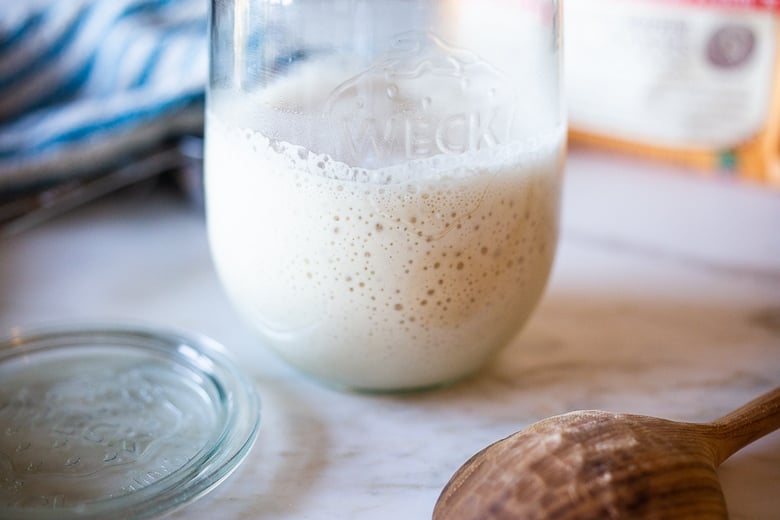
Understand that your starter has a schedule of its own; it is a living thing, so watch it and pay attention.
If your starter is not rising and falling, look at its consistency. As it metabolizes the flour and gets hungry, it will get runny and liquidy, like to the point where you can pour it right out of the jar. If it is still thick like paste, it’s not done metabolizing (eating)the flour.
Day 5: Feed again, 1-2 times, discarding all but a 1/2 cup the starter each time. Adding 1 cup bread flour and 1/2 cup lukewarm water. The starter should look visibly active, bubbling, rising, hopefully, close to doubling in size.
Repeat day 5 until the starter is rising and falling predictably and is close to doubling in size within 6-8 hours.
TIP #4: If your starter is not rising but there is evidence of hunger (liquidy or liquid at the top) try 3 things: substitute 1/4 cup whole grain flour (add to ¾ cup white bread flour) on your next feeding. Try using mineral water like San Pellegrino instead of water. Stir the starter a few times after feeding to allow more wild yeast from the kithcen to get inside.
DAY 6 Morning: Baking day! Give it one last feeding in the morning: this time discard all but a 1/3 cup. (The reason we are changing this to 1/3 cup is to feed it a little bit more.) Add 1 cup flour (120 grams) and 1/2 cup water, stir, and place it in a clean jar so you can see the action clearly. You can use a sharpie or place a rubber band around the jar to mark the beginning level. The starter should hopefully double in volume within 6-8 hours of feeding.
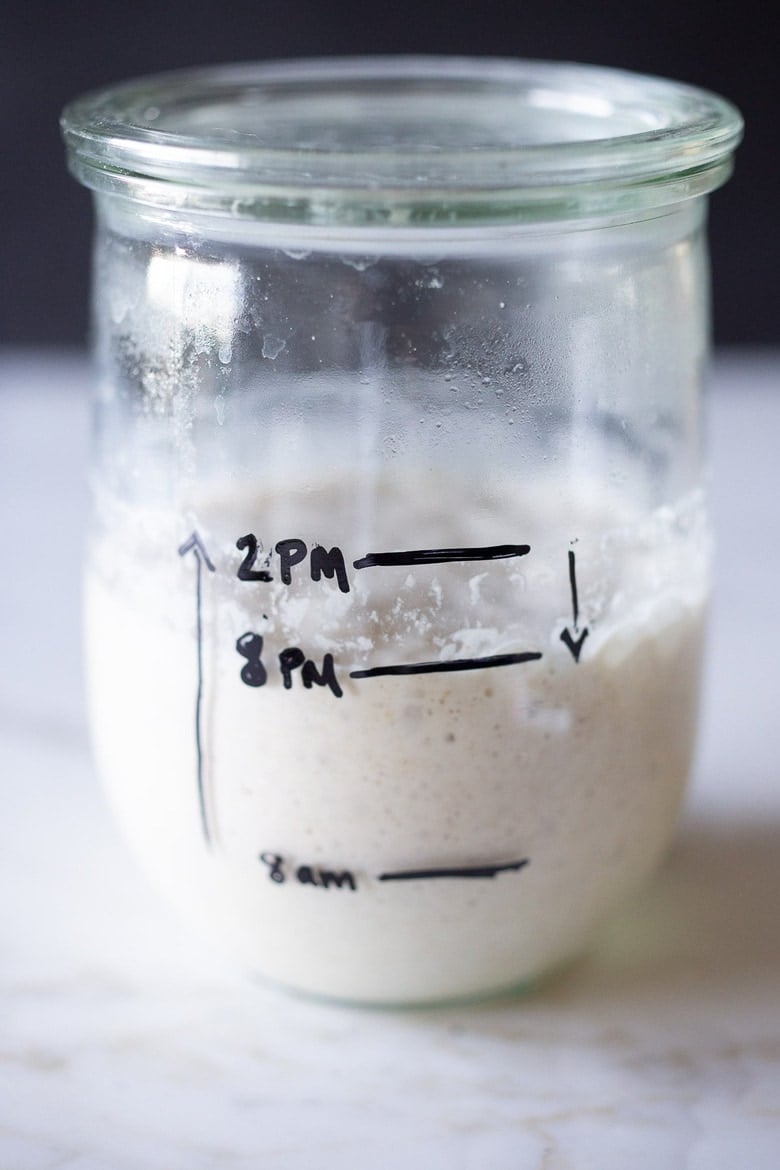
In the photo above, on the 6th day, the starter was fed at 8 am, it peaked around 2 pm, then it started deflating, and by 8 pm, it was “hungry” again. See those downward “slide” marks on the jar?
DO THE FLOAT TEST: When the starter is at its peak, or just after, place a teaspoon of starter (just from the top, don’t stir it down) in a glass full of water; it should hopefully float. If it floats, success!!! Congrats. You can now make our sourdough bread…tonight!
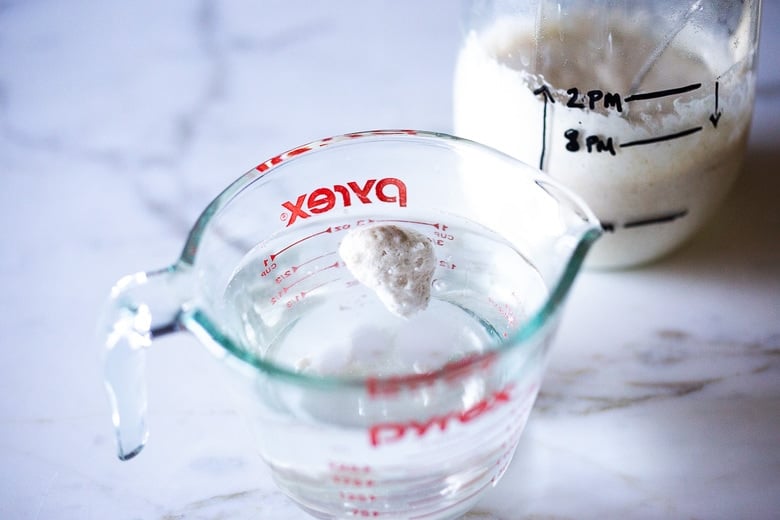
TIP #5: When baking bread always use hungry starter that has already peaked!
STARTER DOES NOT FLOAT? If it doubles in size but does not float, you can still try baking a loaf if it doubles within 6-8 hours of feeding it.
At this point, if your starter does not double in size within 6-8 hours of feeding, don’t give up! Often, it just takes longer, especially during the winter months. Continue feeding one to two times a day until you see a consistent, predictable rise and fall.
Read the troubleshooting section. If you need to take a break, put it in the fridge and try it again up to a week later. Don’t toss it!
Day 6 Evening: Let’s Bake! Use 1/3 cup starter to make this sourdough bread recipe and place the remaining starter (or if not making bread, place all of it) in the refrigerator, and feed it at least once a week, reserving ½ cup starter, before feeding it the usual 1 cup bread flour, 1/2 cup water.
TROUBLESHOOTING Starter
- SMELL: Starter should smell sweet, tangy, earthy, like a wet horse – not “bad”. If it really smells foul or unpleasant, you may have used an unclean jar, unclean utensil, or somehow introduced other bad bacteria. I would start over.
- NO ACTION: On day 4-5 it is typically for it to slow down. If your starter is not rising at all but there is evidence of hunger (liquid at the top, or bubbles) try 3 things. First substitute 1/4 cup whole grain flour (add to ¾ cup white bread flour) on your next feeding. If no rise, then try using mineral water, specifically San Pellegrino instead of water. San Pelligrino specifically has the right mineral ratio, I have great luck with it. Others not so much! Also try stirring the starter a couple of hours after feeding, a couple of times throughout the day to allow wild yeast from the room to get in there. Lastly, you could try pineapple juice instead of water.
- FLOUR: Try to use fresh milled whole grain flour to start, then organic BREAD FLOUR. The more wild yeast in the flour, the better your starter will do- so smaller brands like Bob’s Red Mill seem to do better than bigger conventional brands that have been overly processed. It is totally OK to mix flours and to switch them up- this adds different kinds of wild yeast- a good thing!
- DO NOT overfeed. For example, maybe feeding 2 x day at 12-hour intervals is too often. You want to feed after the starter has peaked, then deflated (see photo above- you’ll see some slide marks on the jar) and this tells you that it is hungry. If you feed the starter before it has had a chance to metabolize (or eat) all the flour (before peaking) and then you discard part of it, and feed it again, you are actually diluting all that amazing bacteria, weakening your starter. So it’s all about watching your starter in your home. If you are not seeing rising and falling, but notice the starter just gets liquidy, this too is a sign of “hunger”. Or if it gets runny enough to pour out of the jar, another sign it is hungry. There are lots of variables here. Just be patient, pay attention and watch. This is a living thing- it doesn’t care about time schedules and recipes or what it “should” do. It will “eat” when it is “hungry” and sometimes it likes to eat slowly. 😉
- TIME: It may take longer than 6 days in colder environments. Use a kitchen thermometer and take its temp. Is it over 65F? Find a place where it can be warm. In the oven with the light on, or in an upper cupboard ( heat rises). Sometimes it takes 12-14 days! Be patient, keep going. If it is doing absolutely nothing, leave it out on the counter for 24-48 hours and see what happens. If you run out of flour or need a break, don’t just toss it, put it in the fridge and see if you can get it going a few days later.
- ACIDITY: If you still can’t get that starter going, some people recommend subbing pineapple juice for the water for one feeding- raising the acidity level. My good friend just tried this and it got hers going.
- LIQUID: If you see any liquid at the top of your starter, it means your starter is hungry. So, yes it’s still alive which is a good thing! You can stir the liquid in, or pour the liquid out, either way, but feed it. This is a sign that you may need to feed it more often.
- MOLD: if you see any discoloring or mold on the surface, starter was probably contaminated. If it is only on the surface, it is probably ok to save. Scrape it off, save 1/2 cup of the underneath starter, and keep going, using a clean jar. Feed, smell, use your best judgment.
- FLOAT TEST: Try testing when your starter is peaking. Take a spoonful from the top without stirring it down. If your starter is rising and falling consistently, but not passing the float test and it has been over 8-10 days- just try baking a loaf. People are having luck with good loaves without passing the float test. It may be the flour…
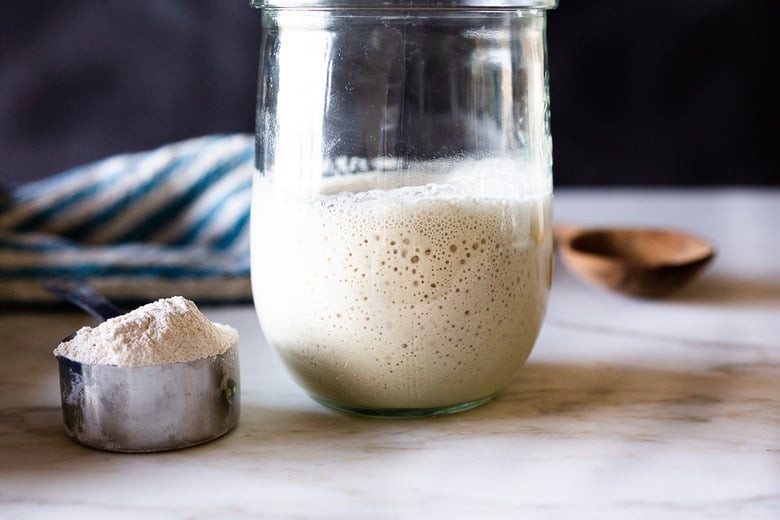
How to Maintain Your Starter
- REFRIGERATE & FEED AT LEAST ONCE A WEEK: Pick a scheduled day and try to stick with it, always reserving 1/2 cup and feeding it 1 cup flour and 1/2 cup water. Discard the remaining, give it away, or keep the discard in a separate container for sourdough pancakes, sourdough buns, banana bread, biscuits, etc. I usually don’t feed the discard unless I give it away.
- If you forget to feed it one week, it is most likely OK; feed it 1-2 times a day for 1-3 days in a row to revive it (keeping it out on the counter) until bubbly and active and doubles within 6 hours. I’ve left my starter for a month on vacation (in the fridge) without feeding and simply revived it by feeding it 3 days in a row, 1-2 x day. It’s surprisingly hard to kill. You can also freeze it for more extended storage.
- This batch will allow you to bake 2 loaves of bread per week with enough left to feed for the next week. If you want to bake more often, you can keep it out and feed it 1-2 x daily. Or if baking every few days, you can pull it out of the fridge, feed it 10 hours before using, leaving it out, use what you need while it is peaking (or slightly after), then put it back in the fridge that evening. Do the same thing a few days later when ready to use again. So this would be feeding 2-3 times a week, best if baking 4-5 times a week.
The best time to use sourdough starter is just after it peaks or on its way down when you know it is hungry.
Sourdough Bread Starter FAQs
Yes. While you are building your starter, during the first week, it is the simplest, easiest, fastest, and most economical way to create a healthy starter. (Or save it separately -in the fridge- and use it in Pancakes, Waffles, Buns, or Biscuits. ) This is because you always have to feed it two times its volume in flour. For example-if you kept all the 1 1/2 cups of starter, you would have to feed it 3 cups of flour (instead of keeping just a 1/2 cup and only feeding it ONE cup). Discarding will shorten the fermentation process, require less flour in the long run, and create a stronger starter. Once your starter is “established” after the first week- then you can give it away to friends, use it in pizza dough, pancakes, etc) or give it to a friend.
How to use your Sourdough Starter
- See all our Sourdough Recipes!
- Sourdough Scones
- Sourdough Crackers
- Sourdough Biscuits
- Sourdough Buns
- Sourdough Tortillas!
- Vegan Banana Bread
- Overnight Sourdough Waffles
More from Feasting At Home
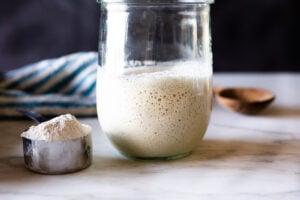
Simple Sourdough Starter
- Prep Time: 30
- Cook Time: 6 days
- Total Time: 144 hours 30 minutes
- Yield: 1 ½ cups
- Category: sourdough, fermented, cultured, bread, baking,
- Method: fermented
- Cuisine: bread
- Diet: Vegan
Description
How to make your own Sourdough Starter (see the step-by-step video in post) using simple ingredients with no special equipment, in 6 days, that can be used in sourdough bread. Sourdough Starter is a wild yeast, made from fermenting flour and water.
Ingredients
- 120 grams whole grain flour (whole wheat flour, rye flour, or freshly milled flour) 1 cup, fluffed, spooned and leveled
- Organic White Bread Flour (5-10 lb bag ) I like Shepherd’s Grain or Bob’s Red Mill.
- 120 grams Water per feeding (1/2 cup water)
Instructions
-
- Day 1: Starting in the morning or at night, using a wide-mouth quart jar or Crock or Glass Measuring Cup mix 1 cup whole grain flour (120 grams) with 1/2 cup (120 grams) filtered water using a fork making sure you’ve incorporated all the dry flour. For your first measuring – it is a good idea to weigh the flour, using a kitchen scale so you get an idea of how thick it should feel. It should be like a thick paste. Thick like peanut butter. If you need to add a little more water to incorporate the flour, that is OK, but be precise with the flour. Place the lid on top (using the Weck jar is really handy here) or a damp towel to keep moisture in, or plastic wrap- and let sit at room temperature (70-80 degrees) on the kitchen counter for 24-48 hours, or until you see some bubbling. If you are not sure how warm it is, use a kitchen thermometer and check it a few hours later. See notes for TEMPERATURE.
- Day 2: After the first 24 hours, you may or may not see a bit of bubbling. I prefer to let this rest until I see a tiny bit of activity (bubbles) and sometimes this takes 36 or up to 48 hours. So start “day 2”, when you see a little bit of bubbing. Discard all but 1/2 cup (136 grams) of the starter. (See notes for discard). Add to the remainder, 1 cup of white bread flour, (120 grams), spooned and leveled, and 1/2 cup filtered water (120 grams), mixing well with a fork. Place the lid on loosely again and allow the mixture to sit at room temperature (70-80F) for another 24 hours.
- Day 3: By the third day, you should definitely see some bubbling- and if not, let it go a bit longer. Depending on how warm your house is and how active your starter, you may need to begin feeding more often, or even move to two feedings a day roughly 12 hours apart, like in the morning and at night. In a nutshell, you want to feed the starter only after it has peaked (metabolized all the flour from the last feeding) and has started sinking down or gets liquidy- this is when it is hungry! This might be 12 hours, it might be 14, it might be 18, or 24, depending on the temp in your house. In very warm climates it may only be 8 hours. It is better to underfeed rather than overfeed here. For each feeding, like before, discard all but 1/2 cup of the STARTER (keeping roughly ½-cup of starter in the jar -4 ounces or 136 grams) Add 1 cup Bread Flour (spooned and leveled) and 1/2 cup water to the 1/2 cup starter and let this rest at room temperature for 12-24 hours or until the starter looks “hungry” again before repeating.
- Day 4: Feed 1-2 times, discarding all but 1/2 cup of starter EACH TIME. Feed 1 cup bread flour, 1/2 cup water. Look for the hunger signs. Hopefully, you’ll begin to see some rising and falling. It’s helpful to put the starter in a clean jar and mark the beginning level (with sharpie, string or rubber band) so you can easily see this. ***If for some reason your starter looks like it is still rising at the time of second feeding (at night) and there is no evidence it has fallen or no slide marks, it is still “eating” so skip this feeding and feed first thing in the morning. AGAIN, Feeding it when it is “not hungry” will basically dilute all the growing yeast and make it lethargic. Better to starve than overfeed.
- Day 5: Feed again, 1-2 times, roughly 12 hours apart, or when hungry, discarding all but a 1/2 cup the starter EACH TIME. 1 cup bread flour, 1/2 cup lukewarm water. The starter should look active, bubbling, rising, sliding down, hopefully, close to doubling in size. (If not, repeat this day until starter doubles in size within 8-12 hours of feeding- and read the troubleshooting section.)
- DAY 6: Give it one last feeding. Discard all but a 1/3 cup. Add 1 cup flour ( 120 grams) and 1/2 cup water, and place it in a clean jar so you can see the action clearly. You can use a sharpie or place a rubber band around the jar to mark the beginning level. The starter should hopefully double in volume within 6 hours of feeding. When it peaks, DO THE FLOAT TEST: To test the starter, place a teaspoon of starter (just from the top, while it is peaking, don’t stir it down) in a glass full of water, it should hopefully float. If it does, you can make sourdough bread. Tonight! Let the starter keep resting at room temperature or a few more hours allowing it to fully metabolize the flour, perhaps sinking a little before making your dough. You want to make dough with slightly hungry starter. Place the remaining starter in the fridge and feed it in a week. You’ll have enough stater to make one more sourdough loaf during the week, and still have enough to feed. If you want to wait to make bread until later in the week place starter in the fridge. Be sure to feed it in 7 days. Read maintenance section.
- At this point, if your starter does not double in size don’t give up! Often it just takes longer, sometimes up to two weeks, especially if it’s cold. Continue feeding one-two times a day (only when hungry) for a few more days, until you see a visible rise and fall. Read the troubleshooting section. If you need to take a break, just put it in the fridge and try it again up to a week later. Don’t toss it- if there are bubbles, it is still alive.
- This batch of starter will make two loaves of bread with enough left over to feed for the following week.
Notes
- TEMPERATURE: The colder your home, the longer it will take for the starter to grow and become active (bubbles). Find a warm spot (70-80 degrees) for the best results. On the stovetop, with the light turned on, or on top of the fridge. Or in the oven with the light on. On top of a heating pad (set to low) with a towel in between). You can still make the starter in a colder home, it will just take longer- even up to 2 weeks.
- FLOUR: Always try to start the batch by using organic, freshly milled whole-grain flour (wheat or rye) because it has more wild yeast in it than All-Purpose or white flour and will get it active and growing sooner. You can, of course, continue to use whole grain, but I’ve had the best luck using organic “bread” flour for days 2 through 6. People have made a sourdough starter with All-Purpose flour- but personally, this has never worked for me– there are fewer nutrients and wild yeasts in the flour and results in a very lethargic starter. If it is your only option, try mixing in 2+ tablespoons of whole-grain (wheat or rye) with the AP flour per feeding. Feel free to use different flours or mix different flours together. It is OK to use all-purpose flour if in a pinch, but using it repeatedly will result in sad starter.
- WATER: I usually use tap water -but sometimes the chlorine in tap water can inhibit the growth of your starter. Lukewarm water helps fermentation to start faster. Sterilized bottled water is often overly sterile, and can also inhibit. Mineral water, like Perrier (carbonated is OK) can sometimes work miracles.
- HYDRATION: Hydration refers to the ratio of water to flour in terms of weight. It is a ratio. The starter is typically at 100% hydration- meaning equal parts flour and water, in terms of weight. So if you use 120 grams of water, use 120 grams of flour. This roughly translates to 1 cup of flour and 1/2 cup water. Feel free to weigh instead of measure if you want to be more precise, or want to familiarize yourself with the consistency you are aiming for. If using whole grain flours (which tend to be “thirstier”) and your starter seems very thick, it is totally OK to add more water to thin it a bit. I intentionally keep the hydration a little lower here (a thicker starter) so you can more clearly see the rise and fall “action” in the jar.
- STORING AND FEEDING: When your starter is kept cold, in the fridge, you don’t need to feed it as often- only once a week. Feel free to feed it “cold”, and put it right back in the fridge if you like. If you keep it out on the counter, you’ll likely need to feed it 1-2 x daily (or just watch and feed only when hungry). Cold slows down the fermentation, heat speeds it up.
- USING: When you need to use your starter for baking bread, feed it 10-12 hours before making bread dough, using it after its peak height. For a more “sour” flavored bread, use the starter straight from the fridge, 3-6 days after feeding. The starter gets more sour tasting the longer it goes without feeding. Feeding the starter the same day as making bread will produce a milder sourdough flavor.
Nutrition
- Serving Size: 1 tablespoon
- Calories: 31
- Sugar: 0 g
- Sodium: 0.2 mg
- Fat: 0.1 g
- Saturated Fat: 0 g
- Trans Fat:
- Carbohydrates: 6.2 g
- Fiber: 0.2 g
- Protein: 1 g
- Cholesterol: 0 mg
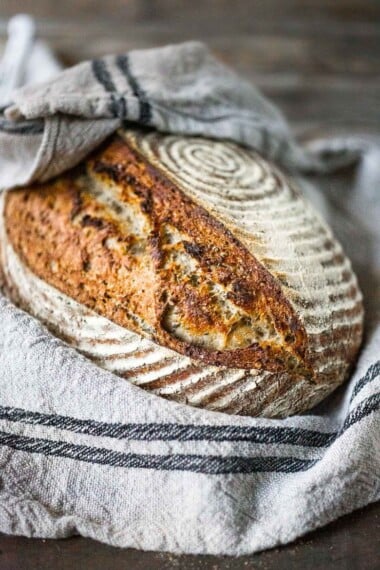

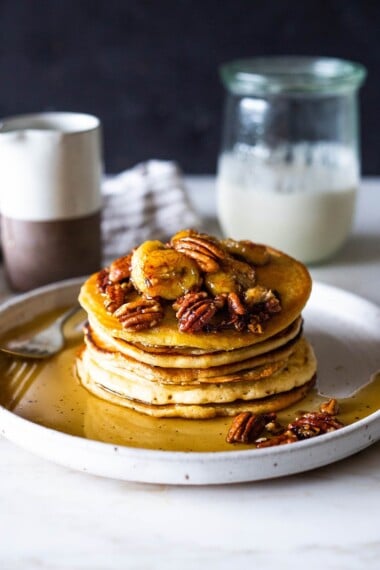
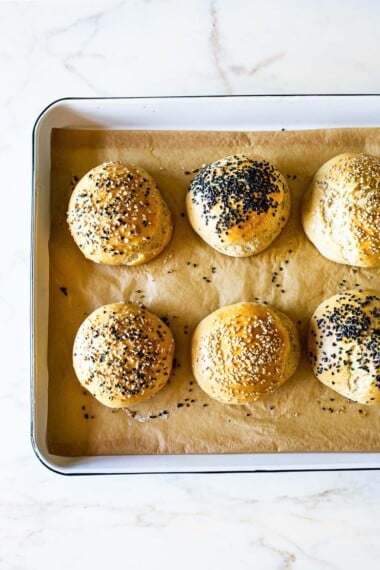






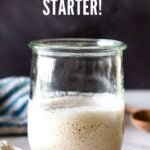
Help! After the first 3 days of doing well, my starter seems to have just… stopped. I’m on day 5, probably 4 hours since feeding and it hasn’t risen, just a couple of bubbles on the top. It didn’t rise yesterday either. Should I start over?
If it is bubbling, just be patient, it is still alive. Look at troubleshooting section for clues.
Hi!
I am currently on day 11 and my starter does not quite double in size. However it passes the float test. Can I still make bread? I have been using King Arthur All purpose flour mixing in whole wheat flower every now and then. What should I do to get the growth needed?
I think you should just give it a try and bake. Or if you want, let the starter get really hungry, then try feeding with mostly whole wheat. But I bet it is fine now. Using AP flour doesnt give it the same rise but it sounds like it is fine!
So I started this about 5 days ago and on the 2nd and 3rd day it looked good and smelled good – sweet and tangy. It still looks right but the smell has gotten really strong and not sure if there is something wrong with it. I have had a starter before and don’t remember this strong smell. How can I tell if there is something wrong with it? It is growing and everything like it should be ?
When you say strong- do mean bad? The smell is likely from fermentation. Which yes, can smell strong, especially when hungry. Was your jar clean?
It does smell like strong fermentation. It was clean before I started the whole process. I understood that I shouldn’t switch jars until the starter was completed – after like 6 days. Should I have been washing every time i fed it?
You can switch jars and clean jars. The video may help clarify. Maybe your starter is just very active and happy?
HELP!
Hi! I was feeding one of my starters last night and wasn’t paying attention. I forgot to discard half of it out before I added flour and water. I only realized after I started mixing and questioned why it was so thick… Suggestions on how to proceed?
This morning it appears to be really bubbly 1-2 inches from the top but the further down the jar goes, it’s less bubbly. They had been in my fridge for almost a week since the last feeding, so I’m sure they are just slower to eat and I was planning on feeding the, again later today, but I’m not sure what to do with the starter that I forgot to discard.
So just wait until it looks hungry- discard all but 1/2 cup and feed like normal. Basically, at your last feeding, you only fed it a snack. 🙂
Hi, I am on day 17. Starter won’t float. Since day 10, starter gets bubbly/foamy after about 8-10 hours1, then sinks very slightly. I don’t see skid marks. I wait (marking jar with post-it flags) another 1-2 to make sure it’s finished growing and then re-feed. I’m using most white whole wheat and whole wheat flour. I also tried bread flour and got less activity. Thermometer on counter says 70-76 degrees. I’m weighing and measuring flour. Per advise to another reader about starter not floating, I did risk using it for bread but the dough would not rise. I’m stumped. Any ideas?
Hummm, interesting! Why don’t you skip a feeding- like let it go 24-36 hours, let it very hungry before feeding the next time and see what happens.
Well, I finally succeeded, on Day 27. It never did float but it was consistently doubling in about 4 hours. I’m wondering if the problem I had at the proofing stage a few weeks ago was due to the room being too warm? Thanks for your help! (I also made your vegan banana bread recipe!)
It could be, yes! Thanks!
I started with whole wheat flour on day one and then started using organic type 80 wheat flour. It is not rising but bubbling and seems quite thin. Smells good but should I change flours? I’m also using distilled water
As long as you are weighing the flour it should be ok. You can use a little less water if you want? But keep flour weight the same.
It’s going crazy after I decreased the water to 1/3 cup!! Now I’ll let this continue for a few days and do a float test. But my question is how much water should I use when I actually start baking?
Just use what you are using. 🙂 1/3 cup is fine if the consistency looks similar to video. Or if you want to increase it that is fine too.
I finally decided to go ahead and do my own starter. Today is day 2, I fed it in the morning, and less than 12 hours later it doubled its size, what do I do? It’s about to reach my containers capacity and I still have to leave it overnight and I am getting anxious it will overflow or get ruined. What do I do? I wasn’t expecting this much activity and I did discarded the leftover following the right amounts.
This is not a problem- this is a GREAT sign. Just put a plate under it. It is OK, it just means your starter is happy and alive!
Perfect! Now I have a second issue 🤣 I am not sure ig in the feed from the morning I put 1 cup or 1/2 of flour. It looks mlre liquidy than normal and It didn’t rise much. I see it deflated just a bit. Should I go ahead with the second feed?
Yes, I would.
I am trying to make this starter but only have access to all purpose flour and bread flour (stores are sold out of the other). Day 1 I used All Purpose flour and Day 2 Bread Flour. It’s been 9 hours since taking the 1/2 cup starter and adding the water and bread flour and the starter is rising and rising. It is about to overflow the jar. Do you know what is going on?
Have you watched the video- it may help clarify. It is doing exactly what it needs to do. All is well. 🙂
All is good with the starter, yeah! It passed the float test. Now my question is when I feed it once a week, removing it from the refrigerator, do I leave it on the counter for the day to see it rise and sink before putting it back in the refrigerator or do you feed it and put it right into the refrigerator?
Just feed and put it back in.
Hi! I’m on Day 2 (just made the starter yesterday), and a little bit of liquid has separated out. There are bubbles, but only in the liquid. Is this normal, or did I do something wrong? Should I feed it tonight and continue the recipe?
Thank you!
Liquid means it process the flour and is HUNGRY. Feed it now. 🙂 It is fine!
Hello, I live in Paris. I have made the sourdough starter , it worked perfectly. I have made the bread. Could not beleive my eyes when I saw the bread rising and being perfectly cooked , not at all dense, but just right. Your explanations are generous, clear, to the point . You take your time to go at length taking us step by step through the recipe. Thank you so much. Would you by any chance have a recipe for sourdough “Brioche”?
Hi Nadine! Funny you should ask! Working on that!
Thank you so much. Meanwhile will try the banana cake.
Have a lovely week end
Cheers from Paris
Nadine
We used the recipe and it worked perfect the first time , we were able to make bread. We store it in the fridge for a couple of days, then we took it out fed it, and it is doubling its size beautifully every 4 hours, but when we try to do the float test it sinks…
What could be happening?
Thank you for your help
Adriana- I don’t think it needs to continue to float to make bread- at least that is what I keep hearing from readers. Just go ahead and bake with it.
Followed your advice, and now we have a gorgeous loaf! Thank you!
I’ll on day 3 and truly appreciate your direct instructions. Looking forward to bread made at home. Thank you
Sylvia I just started my starter today. i did not have a kitchen scale so I use the cup measurements. I used Bobs Mill Rye Flour as a first time only starter flour. I did shifted the flour prior to filling the cup measurement. Somehow my mixer was too thick and lumpy(such that it stick to the spatula) so i added more water a little at a time to match the consistency of what i saw in your video and other videos. Now i am not sure if the measurements worked or not. Should i start again or give it a try until 24 hours to see. Is it because i used all rye flour? i read somewhere that rye flour starter combined with bread flour works good plus i had very little leftover to use up.
It should be fine! Just keep going! Use a fork not a spatula. 🙂
Sylvia I am on day 3 today. On day 2 it was great with a lot of bubbles and doubled. I fed it bread flour and now 24 hours later it is not showing a lot of activity but some bubbles only it is not rising. Do i skip a feeding today and see what happens in the morning? yesterday was a unusual hot day and today it is normal so that could be it too
If it seems liquidy, go ahead and feed it- like, will it pour out from the jar? If so feed. If it is stil kind of thick maybe give it overnight.
Everything went well. Thanks for this detailed recipe. Made pancakes from the discard, made one bread using bread machine recipe and another one using oven recipe. Obviously the oven made was very good and given everyone liked it a lot I may be baking it often 🙂
My question is on the starter that I have saved in the refrigerator. I am a little confused so need help. Let’s say i want to bulk rise the bread at night so when should I remove that starter and feed? Please help as I am not sure of this part.
Either feed it that morning, or use unfed starter that has been in your fridge for up to 6 days.
I am actually having the same problem as the person above me. Day 2 my starter doubled in size and then slid down. I fed it day 3, but I couldn’t feed it a second time since it didn’t rise and fall down. Now day 4 I fed it again in the morning even though it didn’t rise and fall down. There were bubbles though, but not liquify. It’s already been 12 hrs on day 4 and the started hasn’t risen at all. I’m not sure what to do 🙁 . I have yet to even start feeding it twice.
Hi Sandra, it is ok if you don’t feed it twice a day. If it doesn’t look hungry, do not feed it. It might be your flour or the temp. Just keep watching your starter, feeding only after it looks hungry (look for the signs). As long as there are bubbles, it is alive. 🙂 Don’t worry too much about the schedule.
I have 2 different brands of whole wheat flour and both measure less than 1 cup for 120 grams. Should I stick with 120 grams or the heaping cup?
Grams!
Sylvia, thank you for the wonderful site. I began a starter using a cup of Grand Traverse Hard Red Spring Wheat on Sunday. Following your instructions, I substituted bread flour in on the second day, and on the third day, my starter blew up! Using the recommended glass container you recommended, my starter was oozing out of the top like a yeast volcano! I dialed the feedings down to 1/2 cup flour & 1/4 cup water, and it still exceeds the volume of the jar,…this is now my third day,…weather has been a bit warm here in Michigan of late, and I’ve taken to putting “Doug” in the refrigerator to ‘chill.’ My question is this…do I keep feeding the starter for the next 3-4 days, twice daily? Will Doug proceed normally in the fridge? How will I know my starter is ready to use? It’s certainly very active!
Hi Kevin- you are lucky to have such active starter! I would still feed for the full 6 days, just to make sure it is strong. After day 6 see if it floats.
i love the videos and exact directions in this recipe. I am on day 7 and i just passed the float test!!! My question is i don’t want to make the sourdough bread until this evening because i don’t want it to over proof over night. Should i put my starter in the fridge for a few hours and start the bread in a few hours or just leave it out until i make the bread? it has already peaked and started to slide down.
THANK YOU AND WISH ME LUCK!
Put it in the fridge!
Can I half the recipe? I only have a 24 oz. jar!
Yes!
Do you think my 24 oz jar will overflow if I keep the original measurements?
It might. My jar is 32 ounces.
This is the best guide for beginners I’ve found. The combo of the video and detailed directions are incredibly helpful. I’m now ready to start tomorrow morning. One question I’m struggling with is regarding the refrigerator maintenance stage- Do I really discard ALL but 1/2 cup of the starter then feed it OR can I simply take out what I plan to use and replace it with equal parts water and flour without discarding so much of it?
If the latter is possible, then what are some of the pros and cons over doing it that way vs discarding/using all but 1/2 cup of the starter?
When it is time to feed- always Use or Discard all but 1/2 cup (feel free to use the discard) but in the jar, you only want to keep a 1/2 cup of starter before feeding it. Does that make sense?
Yes and Ty- I’m on day 2 now. I am using King Arthur’s white whole flour. It doubled overnight in size on day 1. Today it almost tripled Size in less than 8 hours and is starting to go down. My kitchen is in the 70-80 range. I’m about to give it a 2nd feeding because it seems to be taking rather quickly. Is this okay? how does its progression alter when I can use it for bread?
I plan to switch to bread flour as soon as it comes. It’s been hard to find locally and I just ordered some last night.
TY for being so responsive and helpful!
Yes, just feed it when it looks hungry. I would still wait till day 6 to bake though. 🙂
I am following your recipe, so far everything is working great! But today I forgot to discard half of the starter before feeding it.. Did I kill it now? 🙁
No Tess, you didn’t kill it. It will probably get hungry faster, since overall it had less food. Just watch it.
My (first) starter passed the float test and I have just added the water / starter to the flour. Followed the directions to incorporate the liquid with the dry ingredients, but
the mixture seems dry., not a shaggy ball as directions describe. I’ve not altered it this time, don’t want to change any variables until I see how it goes. But does this seem too dry? Would adding more water be a mistake?or is that what I should have done? Directions call for it to sit loosely covered with plastic wrap for 10-14 hours, so will see how it looks in the morning.
Hi Nancy- are you referring to the bread dough recipe? It will seem dry at night and loosen up in the morning.
Hi, is it possible to use King Arthur white whole Flour for this recipe?
You can try it but I suggest using whole grain or bread flour for best results.
I’m on day four and though my starter seems happy I’m realizing I may have made a mistake.. I’ve been using a jar with a lid instead of a towel, Saran Wrap, etc.. is this a bad thing? Or is it ok? Should I just use a towel, or Saran Wrap? Do I need to start over? TIA!
It should be fine, I use a lid, just placed on top.
Just made my first loaf following your instructions. I have impressed my family. Thank you for your brilliant video, I have been following it for 8 days.
Thanks Vicki- glad it is helping!
I am in the midst of working on my starter, and it rises BEAUTIFULLY, is bubbling, and actually overflowing! I have never gotten the deflation, and slide down marks. What should I do??
I just tried a spoonful in a bowl of water and it is totally floating!! I am wondering, if even though I never saw large slide marks (small amount in the beginning), am I still ready to make bread!?
Has it been 6 days?
Maybe just give it a little more time to fully peak. You want it hungry before you feed it again. 🙂
Thank you for the info and fast reply. I really appreciate your feedback!!!
It is half way below the original level. If it does not rise in a week, shall I throw it out?
Thanks!
Maybe- just watch for any activity. Even just bubbles. Bubbles means it is alive and you can coax it.
Hi!
My crust was chewy. Did I under cook it? The bread was fine!
I am doing the feed 1x week with it in refrig. The starter actually dropped after the first 48 hrs. Do I need to feed already?
Thanks!
I would feed it if it looks hungry. I wonder if your fridge is warmer than mine. Mine is at 41F and starter doesn’t drop until day 5-6. Chewy crust: as in it is soft, or too crusty? Sorry, not sure what you mean. You can play with leaving the lid on longer.